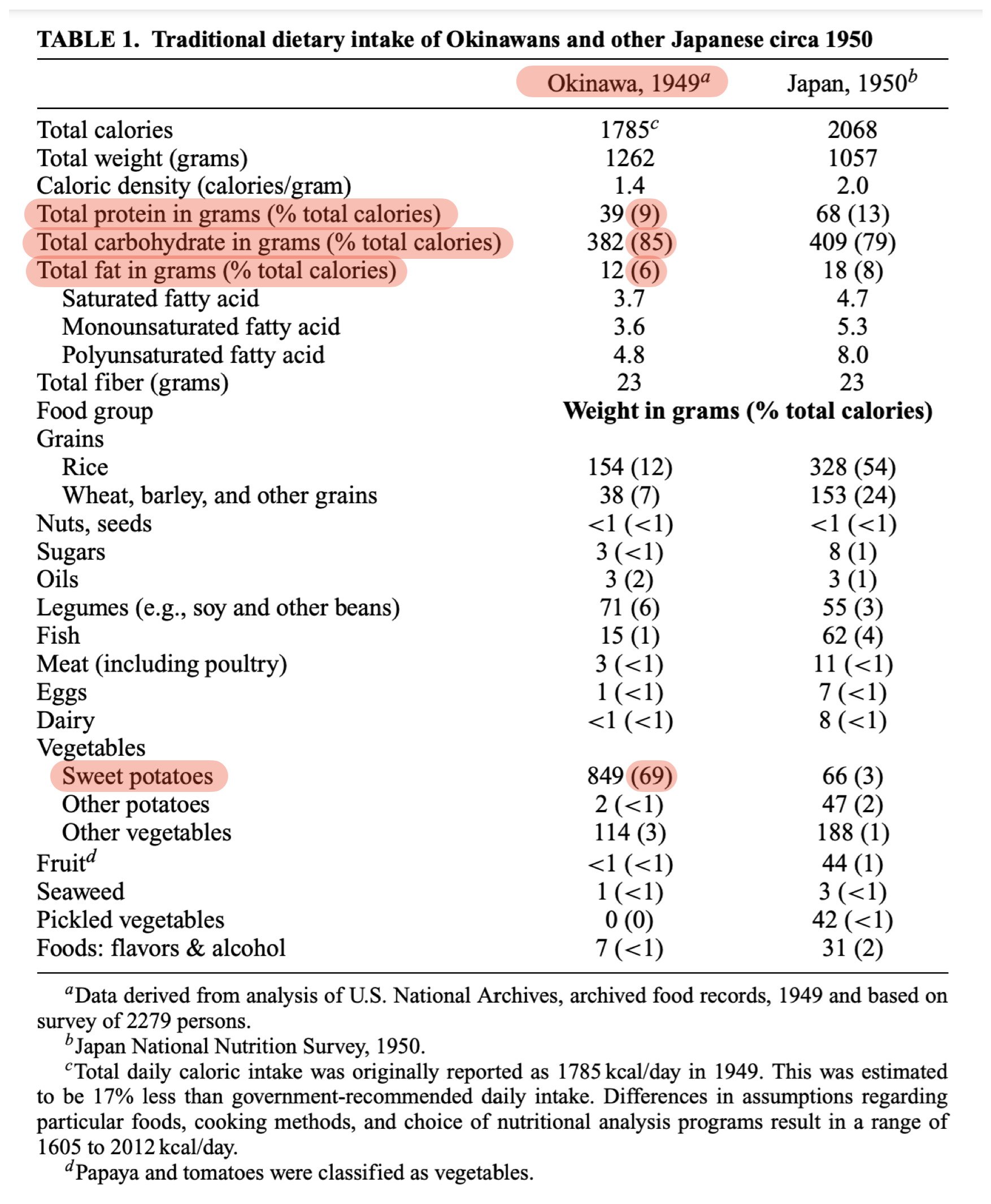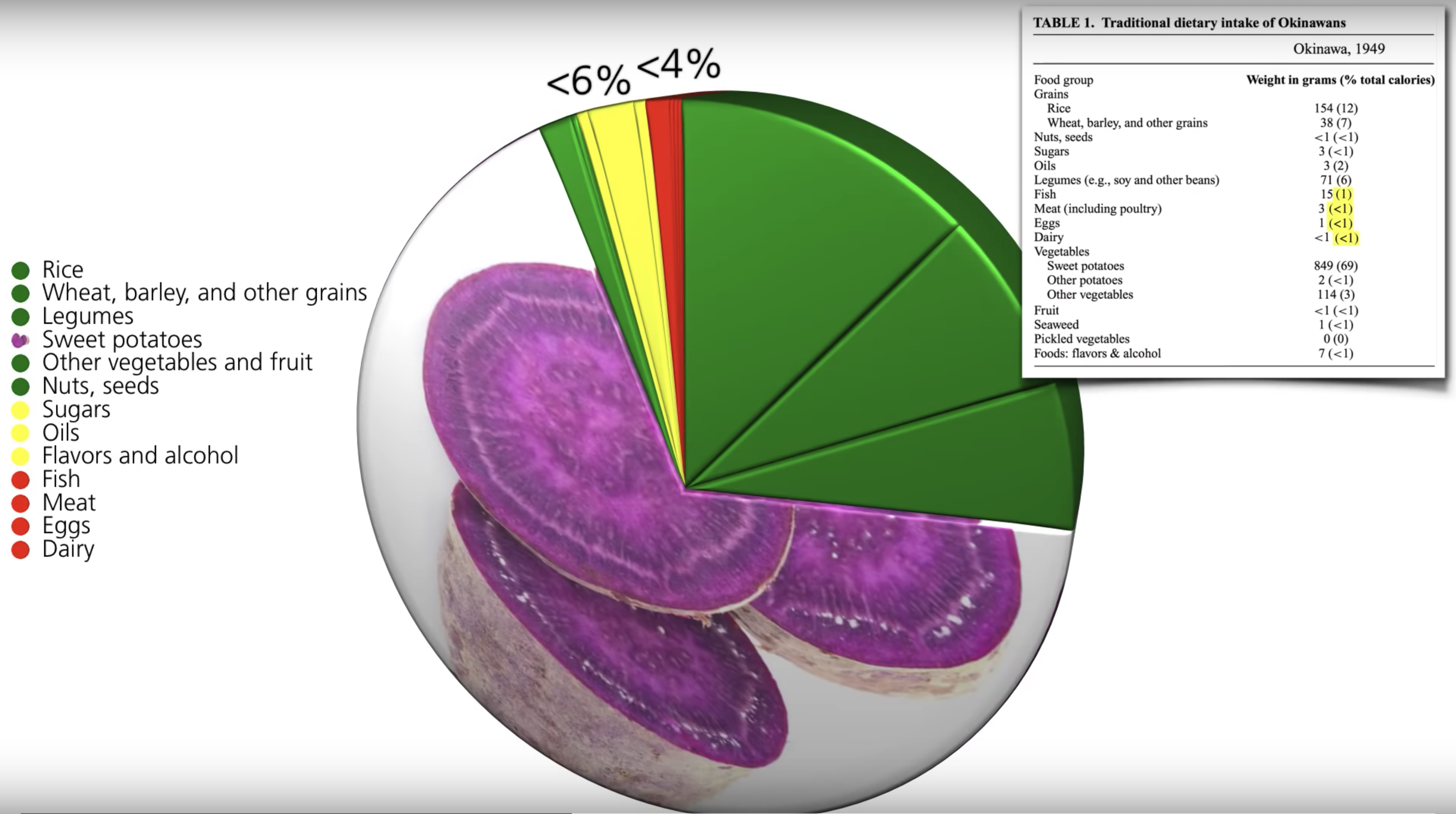Traditional Okinawans are one of the Blue Zone populations, revered for both lifespan (high percentage of centenarians) and healthspan (very low chronic disease rates). Their macro ratios are 85:9:6 (85% carbohydrates, 9% protein, 6% fats) — an example of a VERY LOW FAT diet. Let's focus on proteins though.
Traditional Okinawans ate < 3% of calories from animal products (meat, fish, eggs, dairy). And they derived a whopping 69% of calories from just 1 specific food: purple sweet potatoes! Sweet potatoes are an amazing superfood; pigmented ones are better; purple sweet potatoes are the best! Sweet potatoes are only 7.3% protein (see NutritionFacts for sweet potato). Plus they ate some legumes (71 grams daily; only 6% of calories) and some whole grains. In the West, sweet potatoes are not seen as a protein source but traditional Okinawans got adequate protein from a sweet potato centric diet with some legumes (and <3% calories from meat, fish, eggs and dairy).
Articles by Dr Greger:
Videos by Dr Greger:
Did traditional Okinawans have any heart disease? Heart disease is the #1 killer of men & women in the world, and in many many countries like US, UK and India!
Excerpt from A plant-based diet and coronary artery disease: a mandate for effective therapy by Dr Esselstyn, J Geriatr Cardiol, 2017 May; 14(5): 317-320:
"It is increasingly a shameful national embarrassment for the United States to have constructed a billion-dollar cardiac healthcare industry surrounding an illness that does not even exist in more than half of the planet. If you, as a cardiologist or a cardiac surgeon, decided to hang your shingle in Okinawa,[3] the Papua Highlands of New Guinea,[4] rural China,[5] Central Africa,[6] or with the Tarahumara Indians of Northern Mexico,[7] you better plan on a different profession because these countries do not have cardiovascular disease. The common thread is that they all thrive on whole food, plant-based nutrition (WFPBN) with minimal intake of animal products."
Excerpt from
An Independent Critique of Low-carb Diets: The Diet Wars Continue (2013):
The Okinawans
"In 1949, a government survey found that in Okinawa, known to have the highest concentration of centenarians in the world, the population consumed about 85% of their total energy intake from carbohydrates, with the staple at the time being the sweet potato. The dietary survey also showed that the Okinawans derived about 9% of their energy intake from protein and less than 4% of energy from all sources of animal foods combined (Table 1).10 These findings were largely consistent with previous dietary surveys dating back to 1879 and 1919.11"
"In 1946, Steiner examined autopsies of 150 Okinawans, of which 40 were between the age of 50 and 95. Steiner noted only seven cases of slight aortic atherosclerosis, all of which were found in those over the age of 66, and only one case of calcification in the coronary arteries. In 1946 Benjamin reported similar findings from a study of 200 autopsies on Okinawans.12"
"Even in 1995 the observed rates of coronary heart disease and dietary related cancers, including that of the colon, prostate, breast and ovarian in Okinawa were not only many fold lower than that of the United States, but even significantly lower than that of mainland Japan.10 This may be explained by the likelihood that these diseases are slowly progressive diseases and therefore the more traditional Okinawan diet consumed several decades prior would still have played a major role in the development and manifestation of these diseases.13 14 15"
How healthy are modern Okinawans? An excerpt from
What Do the Longest Living People Eat? (2018) by Dr Greger:
"Okinawan longevity is now a thing of the past. Okinawa now hosts more than a dozen KFC restaurants. Okinawans’ saturated fat levels have tripled. They went from eating essentially no cholesterol to a few Big Macs’ worth. They tripled their sodium and are now as potassium-deficient as Americans, getting less than half of the recommended minimum daily intake of 4,700 mg a day. In just two generations, Okinawans have gone from the leanest Japanese to the fattest. As a consequence, there has been a resurgence of interest from public health professionals in getting Okinawans to eat the [traditional] Okinawan diet too!"
Let's circle back to proteins in the traditional Okinawan diet. They consumed only 9% calories as proteins (derived from purple sweet potatoes and some legumes as primary sources) for excellent lifespan (high %age of centenarians) and healthspan (very low chronic disease rates)!



 Instagram
Instagram YouTube
YouTube